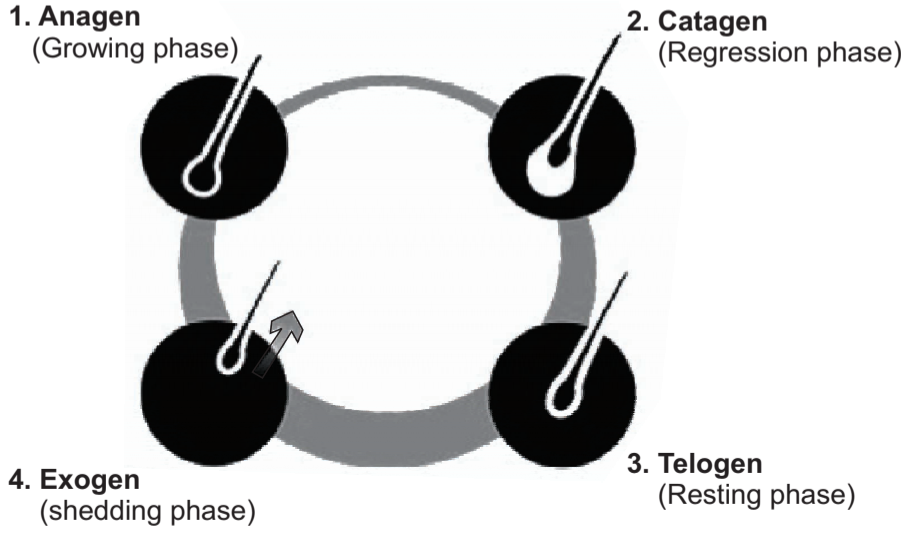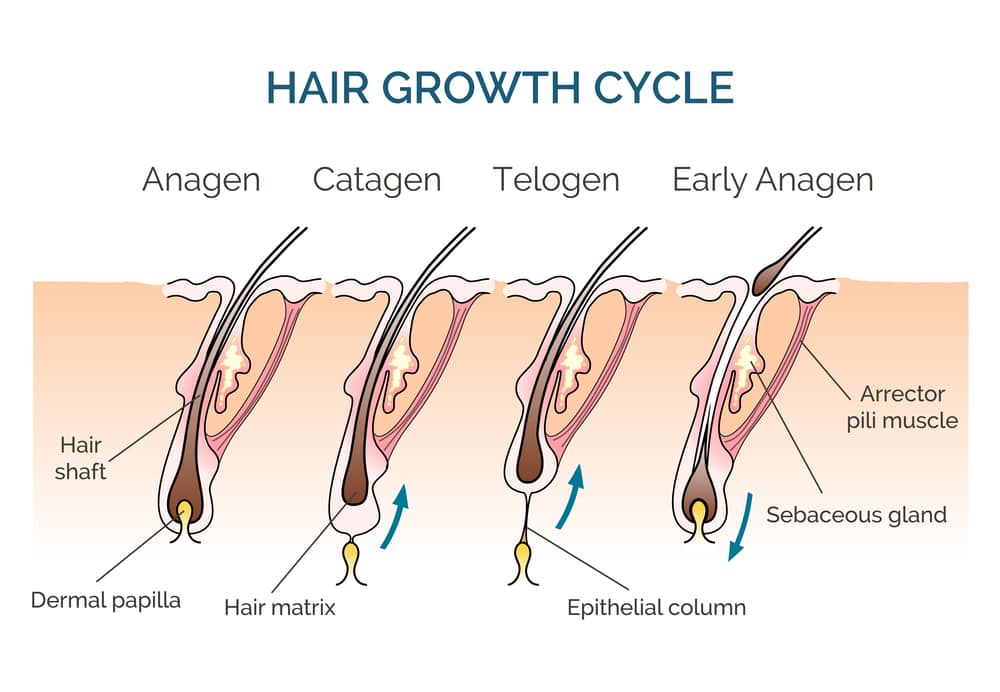Hair Growth Cycle: Hair grows from the follicle, or root, underneath the skin. The hair is ‘fed’ by blood vessels at the base of the follicle, which gives it the nourishment it needs to grow. Between starting to grow and falling out years later, each hair passes through four stages: anagen, catagen, telogen, and exogen (Fig.1). Another stage kerogen has been recently realized. Every hair is at a different stage of the growth cycle. Over time, the length of the anagen stage decreases. Therefore, the hair may become weaker and thinner after each cycle. That is why it is important to ensure a diet rich in specific nutrients to maintain normal, healthy hair growth. If hairs enter the resting phase too early, excess shedding and noticeable thinning of the hair can occur.
1. Anagen phase
Table of Contents
The first stage is called the anagen stage and lasts approximately 1,000 days. The anagen phase is known as the growth phase. It begins in the papilla and can last from two to six years. Eighty to ninety percent of all human hair is in the anagen stage. This is the period of active growth when the cells around the follicle are rapidly dividing and depositing materials within the hair. The anagen phase is generally longer in Asians and can last as much as 7 years with hair being able to grow to 1 meter. The span at which the hair remains in this stage of growth is determined by genetics. The longer the hair stays in the anagen phase, the longer it will grow. During this phase, the cells in the papilla divide to produce new hair fibers, and the follicle buries itself into the dermal layer of the skin to nourish the strand. About 85% of the hairs on one’s head are in the anagen phase at any given time.

2. Catagen phase
At the end of the anagen phase, hair enters the catagen phase. It is a short transitional phase that lasts approximately 10 days. The first sign of catagen is the cessation of melanin production in the hair bulb and apoptosis of follicular melanocytes. The catagen phase, also known as the transitional phase, allows the follicle to renew itself. During this time, which lasts about two weeks, the hair follicle shrinks due to disintegration and the papilla detaches and “rests,” cutting the hair strand off from its nourishing blood supply. Ultimately, the follicle is 1/6 its original length, causing the hair shaft to be pushed upward. While hair is not growing during this phase, the length of the terminal fibers increases when the follicle pushes them upward. The catagen stage follows as the hair grows and changes (perhaps turning gray). The catagen stage accounts for about 2% of all hair growth and development.
3. Telogen phase
This is the final stage of hair growth. During this stage the hair follicle is dormant or resting and hairs are easily lost. About 10 to 18% of all hairs are in the telogen stage. The follicle then remains inactive for 3 months and the whole process is repeated. During the telogen or resting phase, the follicle remains dormant for one to four months. 10 to 15% of the hairs on one’s head are in this phase of growth at any given time. In this phase the epidermal cells lining the follicle channel continue to grow as normal and may accumulate around the base of the hair, temporarily anchoring it in place and preserving the hair for its natural purpose without taxing the body’s resources needed during the growth phase. At some point, the follicle will begin to grow again, softening the anchor point of the shaft initially. The hair base will break free from the root and the hair will be shed. Within two weeks the new hair shaft will begin to emerge once the telogen phase is complete. The process results in normal hair loss known as shedding.
4. Exogen phase
The long hair shedding function has been assumed to be part of the telogen phase, but now it has been established that shedding occurs as a distinct phase termed as exogen phase. Current research views the shedding of the hair fiber as a highly controlled, active process. Accordingly, the process differs from the quiescence normally found during the telogen phase. As such, the term “exogen” is used to describe this event as a specific process of its own during hair follicle cycling. The former studies in this regard assumed that the newly formed hair fiber pushes the resting shaft outward to affect hair shedding. The morphology of the hair root suggests that the exogen process involves a proteolytic event that occurs between the moving cells of the telogen shaft base. What makes this shedding process possible is still unknown. A possible role of desmoglein and proteolytic events has been suggested. Another theory is that the process of exogen has at least two steps: After a variable time in telogen, the follicle base cells receive a signal, or series of signals, that initiate exogen. The latter turns on the effectors of shedding.
5. Kenogen phase
Scientists observed a novel phenomenon in hair cycling when they used phototrichograms to study hair growth – the empty hair follicles were noticed even after shedding the hair fiber. Thus the term “kenogen” was coined to describe the interval of the hair cycle in which the hair follicle remains empty after the telogen hair has been extruded and before a new anagen hair reappears. It is normal to observe Kenogen in healthy skin; but in men and women with androgenetic alopecia, the frequency and duration of kenogen have been reported to be greater.
Each hair follicle is independent and goes through the growth cycle at different times; otherwise, all the hair would fall out at once. There is no pattern as to which hairs on the head are in a particular stage at any time. Instead, a certain number of hairs is shed each day – up to 80 hairs on a healthy head of hair. Hair loss, hair thinning, and problems with hair growth occur when the growth cycle is disrupted. This can be triggered by conditions such as metabolic imbalances, illness, or improper nutrition.
Make sure you also check our other amazing Article on : Cold Cream
